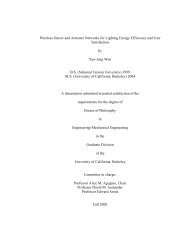Insulation
Insulation
Insulation
You also want an ePaper? Increase the reach of your titles
YUMPU automatically turns print PDFs into web optimized ePapers that Google loves.
The downside of fiberglass comes with the insulation of small hard to reach areas of the<br />
building. Because fiberglass normally comes in large pre-cut sizes, it is not as flexible as<br />
cellulose or spray foam. Also it is resiliency to water or moisture is relatively weak.<br />
During installation it’s important that the environment is controlled so that little or no<br />
moisture leaks into the wall. When the fiberglass gets wet, it crunches up together and<br />
starts sagging. This leaves gaps in the walls with for air and heat to penetrate. There are<br />
also acute and long term health effects associated insulation. However, majority of<br />
health effects are due to the exposure of fiberglass which affect mainly the installer or<br />
contractor rather than the inhabitants of the home. Later sections of the paper will<br />
explore the health effects in greater detail.<br />
In summary, Fiberglass has an R-value of 2.9-3.8 m2-K/W per inch which is pretty<br />
average in comparison with the other two types of insulations that were compared. The<br />
STC for fiberglass is also pretty average, better than spray foam but clearly not as good<br />
as cellulose. The advantages of fiberglass include ease of installation and cost, and these<br />
are the primary reasons why fiberglass is still so popular in the market today. Though<br />
fiberglass is falls short when it comes to insulating hard to reach places, often times<br />
homeowners or contractors also use spray foam alongside fiberglass. Fiberglass<br />
insulation is the homeowner’s choice when it comes to self performance, it’s relatively<br />
inexpensive, effective and easy to install.<br />
Cellulose Installation<br />
As one of the primary form of home insulation, cellulose can either be purchased as a<br />
spray-on insulator or in sheets. It is made from recycled newsprint and other paper<br />
sources and accounts for 15% of the total insulation market. It is comprised of old<br />
newspapers, telephone directories, borates, and ammonium sulfate, having a recycled<br />
content up to 85%. Its strength is derived from its fibrous composition, which results<br />
from the hydrogen bonding within the chain and maintains a linear conformation. It’s<br />
typical R value per inch ranges from 3.6-4 m 2 -K/W. However, because of the fiber and<br />
chemical constituents, it can become a source of irritants. The main attractiveness of<br />
using cellulose is its high recycled content and very low embodied energy.<br />
Embodied energy represents the non-renewable energy consumed in the acquisition of<br />
raw materials and their processing and manufacturing. It comprises of direct energy (like<br />
direct transportation of the insulation to the site) and indirect energy, which is the energy<br />
associated with manufacturing of the product. It is a measure of non-renewable energy<br />
per unit of building material. Usually, it is implicative of the environmental resource<br />
depletion, greenhouse gases, environmental degradation, and reduction of biodiversity,<br />
and research has been done to suggest that it can even be a reasonable indicator of the<br />
overall environmental impact of building materials. However, because of building<br />
performance, the embodied energy must be weighted against performance and durability.<br />
From research done by several international sources, against fiberglass and foam,<br />
cellulose has an embodied energy of only 3.3 MJ/kg, while the fiberglass has 30.3 and<br />
polystyrene has 117 respectively, making cellulose a prime choice due to its recyclability.
















